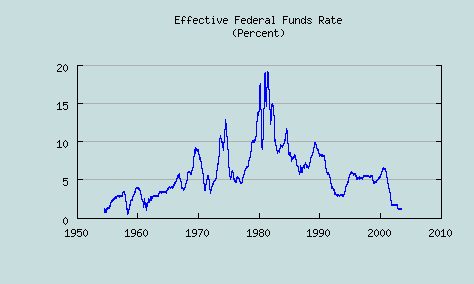Federal Funds Rate (Fed Funds Rate)
The Federal Funds rate is the interest rate on overnight loans between banks. These loans are most often used to satisfy the reserve requirement.
More details from the Federal Reserve Board:
What is the federal funds rate?
The federal funds rate is the interest rate at which a depository institution lends immediately available funds (balances at the Federal Reserve) to another depository institution overnight. The rate may vary from depository institution to depository institution and from day to day.

Why does the Fed increase or decrease the federal funds rate?
The Federal Reserve Act specifies that the FOMC should seek "to promote effectively the goals of maximum employment, stable prices, and moderate long-term interest rates." At each meeting, the FOMC closely examines a number of indicators of current and prospective economic developments. Then, cognizant that its actions affect economic activity with a lag, it must decide whether to alter the federal funds rate. A decrease in the federal funds interest rate stimulates economic growth, but an excessively high level of economic activity can cause inflation pressures to build to a point that ultimately undermines the sustainability of an economic expansion. An increase in the federal funds interest rate will curb economic growth and help contain inflation pressures, and thus can promote the sustainability of an economic expansion, but too large an increase could retard economic growth too much. The Committee's actions on interest rates are undertaken to achieve the maximum rate of economic growth consistent with price stability and moderate long-term interest rates.
●
Classic Economic Models
Interactive presentations of the most important models
in microeconomics and macroeconomics go beyond
anything appearing in a printed-on-paper textbook.
Learn to think like an economist.
Arbitrage Pricing
Arbitrage Profit
Average Cost
Balance of Payments
Budget Constraint
Call Option
Concave Function
Consumer Surplus
Consumption Function
Convex Function
Deadweight Loss
Demand Curve
Econometrics
Economic Agent
Economic Model
Economics
Economics Textbook
Elasticity
Endogenous
Endogenous Technical Change
Equilibrium
Exchange Rate
Exogenous
Expectations Hypothesis
Federal Funds (Fed Funds) Rate
Fixed Exchange Rate
Floating Exchange Rate
Frictional Unemployment
Gross Domestic Product (GDP)
Income Effect
Income Elasticity
Indifference Curve
Interest Rate
Intertemporal Substitution
Jensen's Inequality
Macroeconomics
Marginal Cost
Marginal Product
Marginal Utility
Microeconomics
Monopoly
Optimizing Behavior
Perfect Competition
Phillips Curve
Price Elasticity
Producer Surplus
Production Function
Production Possibility Frontier
Put Option
Recession
Reservation Wage Rate
Risk Aversion
Structural Unemployment
Substitution Effect
Supply Curve
Taylor Rule
Technological Growth
Term Structure
Theory of the Consumer
Theory of the Firm
Unemployment Rate
Utility Function
Velocity of Money
Widget
Yield Curve